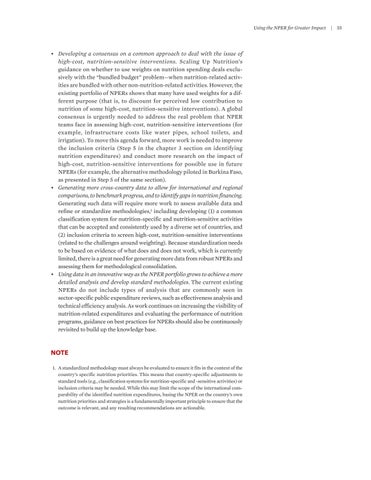Using the NPER for Greater Impact
• Developing a consensus on a common approach to deal with the issue of high-cost, nutrition-sensitive interventions. Scaling Up Nutrition’s guidance on whether to use weights on nutrition spending deals exclusively with the “bundled budget” problem—when nutrition-related activities are bundled with other non-nutrition-related activities. However, the existing portfolio of NPERs shows that many have used weights for a different purpose (that is, to discount for perceived low contribution to nutrition of some high-cost, nutrition-sensitive interventions). A global consensus is urgently needed to address the real problem that NPER teams face in assessing high-cost, nutrition-sensitive interventions (for example, infrastructure costs like water pipes, school toilets, and irrigation). To move this agenda forward, more work is needed to improve the inclusion criteria (Step 5 in the chapter 3 section on identifying nutrition expenditures) and conduct more research on the impact of high-cost, nutrition-sensitive interventions for possible use in future NPERs (for example, the alternative methodology piloted in Burkina Faso, as presented in Step 5 of the same section). • Generating more cross-country data to allow for international and regional comparisons, to benchmark progress, and to identify gaps in nutrition financing. Generating such data will require more work to assess available data and refine or standardize methodologies,1 including developing (1) a common classification system for nutrition-specific and nutrition-sensitive activities that can be accepted and consistently used by a diverse set of countries, and (2) inclusion criteria to screen high-cost, nutrition-sensitive interventions (related to the challenges around weighting). Because standardization needs to be based on evidence of what does and does not work, which is currently limited, there is a great need for generating more data from robust NPERs and assessing them for methodological consolidation. • Using data in an innovative way as the NPER portfolio grows to achieve a more detailed analysis and develop standard methodologies. The current existing NPERs do not include types of analysis that are commonly seen in sector-specific public expenditure reviews, such as effectiveness analysis and technical efficiency analysis. As work continues on increasing the visibility of nutrition-related expenditures and evaluating the performance of nutrition programs, guidance on best practices for NPERs should also be continuously revisited to build up the knowledge base.
NOTE 1. A standardized methodology must always be evaluated to ensure it fits in the context of the country’s specific nutrition priorities. This means that country-specific adjustments to standard tools (e.g., classification systems for nutrition-specific and -sensitive activities) or inclusion criteria may be needed. While this may limit the scope of the international comparability of the identified nutrition expenditures, basing the NPER on the country’s own nutrition priorities and strategies is a fundamentally important principle to ensure that the outcome is relevant, and any resulting recommendations are actionable.
|
55

